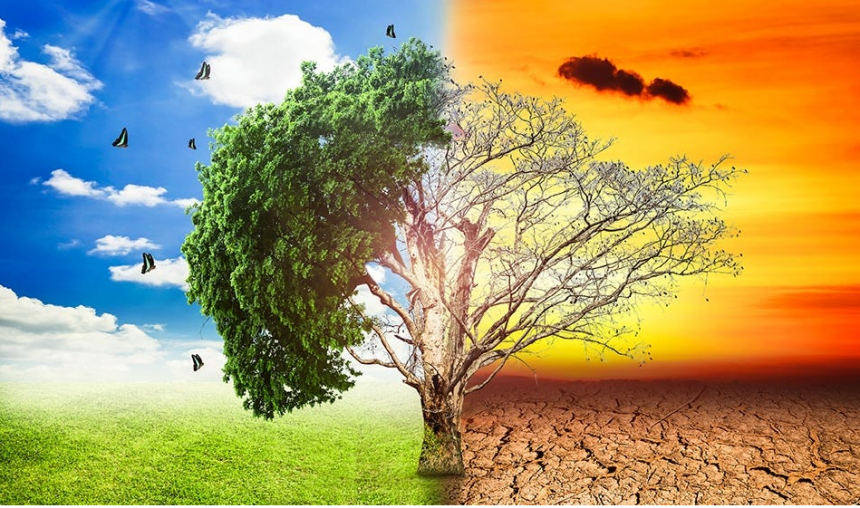PART – II
Many climate impacts especially sea level rise, disappearance of mountain glaciers, melting of polar ice and ocean acidification, is almost irreversible for many generations to come and will take centuries to restore to even today’s conditions. Sea level is rising because of added water from melting land ice and the expansion of sea water as it warms. Global sea level has risen about 8 inches since reliable record-keeping began in 1880.
By 2100, scientists project that it will rise at least another foot, but possibly as high as 6.6 feet in a high emission scenario leading to partial or complete inundation of almost all the coastal cities of the world especially New York, California, Boston, Miami, New Orleans, Mumbai, Chennai, Kolkata, Shanghai, Jakarta, Tokyo, Venice, Amsterdam, Solomon Islands and many more. Maldives, a nation of low-lying islands, faces an essential threat from rising sea levels.
Human health impacts from climate change are now apparent. The cumulative death toll from CChas passed 4 million during the last 25 years. This number is likely on the lower side since it only focuses on climate related malnutrition, diarrheal disease, malaria, and cardiovascular diseases, whereas climate change is a threat multiplier of many other extreme weather events and public health risks (Nature, PLOS).
The agriculture sector’s vulnerability to climate change is a global concern. In addition to reduction in crop productivity and crop quality due to weather fluctuations leading to erratic phenology, poor pollination and stressed growth, the supplies are also threatened. These detrimental effects are concerning with regard to the developing nations where agriculture performs an essential part in assuring both economic growth and food security. Around 14 countries worldwide have at least 75-98% of their exports derived from agriculture. India’s economy and population are significantly reliant on agriculture. Approximately 62% of the Indian population derives their livelihood directly from agriculture and allied fields.
The world population is annually growing at the rate of 0.85%, adding roughly 70 million people per year, which is likely to affect food security in future more because of deteriorating ecosystems. The global issue of hunger and food insecurity has shown an alarming increase since 2015, a trend exacerbated by a combination of factors including climate change. By 2022, approximately 735 million people or 9.2% of world’s population were found in a state of chronic hunger.
Although, the World leaders, at a conference on Sustainable development (Rio+20) in 2012 and just after three years by way of adopting SDGs of Global Agenda 2030, reaffirmed among many other targets the right of everyone to have access to safe and nutritious food, it is projected that more than 600 million people worldwide will be facing hunger in 2030 highlighting the immense challenge of achieving zero hunger target (UN Report).Nevertheless, the worst impact of CC is its disproportionate effect on vulnerable populations, thereby aggravating existing social inequalities and potentially leading to social unrest.
Climate change is damaging habitats, altering species abundance, ranges, and interactions as well as ecosystems worldwide thereby accelerating biodiversity loss. Evidences suggest that a sizeable number of species are facing declining populations, range retractions and possible extinctions. The IUCN Red List is growing. Although, the recent global biodiversity assessments predict extinction risks for around 28% of species due to cumulative effect of many factors, the contribution of CC in species extinction is projected around 7.6% (Science, 2024). Extinctions will accelerate rapidly if global temperatures exceed 1.5 degree Celsius. A number of species, because of habitat destruction, become extinct before we could discover them.
Modifications to the patterns of precipitation are another effect of climate change that contributes to both droughts and floods. India ranks third in the world for its vulnerability to floods, according to World Risk Index. Approximately 40 million hectares, or 12% of India’s land are susceptible to flooding. The states located in India’s northeast are more vulnerable to floods, while the states in the southern and central parts are more vulnerable to extreme droughts.
Climate change disasters especially droughts, floods, and cyclones, lead to displacement of people on a large scale that in turn poses significant challenges in accessing education. At least two and a half million students in 85 countries had their schooling disrupted by extreme climate events in 2024 (UNICEF). Children are more vulnerable to the impacts of weather-related crises, including stronger and more frequent heat waves, storms, and droughts and flooding. They fail to concentrate in classrooms that are ill equipped to offer respite from sweltering heat. They even miss attending their schools due to closure of roads on account of floods or landslides. Natural disasters cause millions of displacements worldwide. In 2022 the figure was 32.6 million followed by a slightly lower figure, 26.4 million, in 2023.
People impacted or displaced by the effect of climate change, despite their highly visible needs, often remain an invisible category in both national and international policy (UNESCO). They face enormous challenges in accessing education through destroyed infrastructure, linguistic barriers, poverty, dropout, discrimination and many more. Although climate-displaced people face similar barriers to education as refugees, they do not meet the criteria outlined in the 1951 Refugee Convention, hence unlike refugees, they have under neither international law neither any specific right to residency nor the explicit right to education.
To minimize losses and damages, it is crucial to reduce urgently and significantly greenhouse gas emissions by phasing out fossil fuels (New Insights, IPCC). Since the world cannot survive without energy and taking a U-turn on the way to industrial ventures is impossible, it becomes essential to focus on novel and innovative technologies that increase the diversity of energy resources. The scientists have to innovate new machines capable of harvesting solar, wind, water, hydrogen and other forms of safe and renewable energy, more efficiently.
To address climate challenge India will have to add 300GW of renewable energy by 2030 to bridge the gap between current capacity and required target of 500GW, requiring an investment of USD 1.5 trillion in renewable energy, biofuels, de-carbonization and sustainable infrastructure (Economic Times, July, 2025). The investment will considerably reduce emissions, boost up job creation, enhance energy security and protect vulnerable communities from climate crisis.
Advocating vehemently and unambiguously in favor of reducing emissions globally by letting the fossil fuel reserves remain buried, the UN Secretary General Antonio Guterres in COP26 conference (2021) held at Glasgow in Scotland said, “It is time to say: enough. Enough of killing ourselves with carbon. We are in fact digging our own graves”. He was quite justified in his heartfelt remarks because there is only one earth to live on but, alas, world economies still realize 80% of their total energy requirements from fossil fuels.
It is high time for all member countries to introspect, and live up to their promises made at United Nations with regard to SDGs, which provide the best possible blueprint for a sustainable future.
(Concluded…)
(Author is Principal (Rtd.) J&K Higher Education Department. Email: [email protected])








